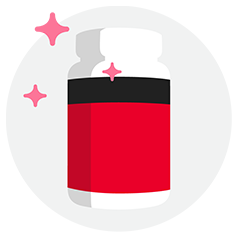How to prevent hyperpigmentation: Summer skincare 101

Summer. It’s the season some of us wait all year to enjoy. It’s the time of year to have a picnic with friends, ride your bike without the extra layers, have a late-night campfire and try all the water sports you can handle. It can feel so good to be in the sun, not to mention all the health benefits – increased vitamin D production, increased bone health, decreased blood pressure, and enhanced mental health. But before you head out to soak up those rays, here are some tips to prevent dark skin spots, hyperpigmentation, and how to protect your largest organ from the inside out.
What is hyperpigmentation?
Have you ever noticed that your skin pigmentation, or colouring, isn’t uniform? Hyperpigmentation is a condition in which a patch of skin is noticeably darker than the surrounding skin.
The epidermis is the outermost layer of the skin, and within this layer is the basal cell layer, where you’ll find specialized skin cells called melanocytes. These are the cells that produce melanin (not to be confused with the sleep hormone melatonin), the pigment that causes various colours in skin, hair, and eyes. Melanin is produced when your skin is exposed to our natural source of UV radiation, the sun.
What’s the cause behind this skin condition?
While hyperpigmentation can be caused by age, diet, allergic reactions, or medication side effects, the main cause is sun exposure (since sunlight is what triggers melanin production in the first place). When exposed to the sun, your skin produces melanin as a defence against the sun, which is why we tan. It’s the body’s way of protecting us from sunburn – kind of like a natural sunscreen. Darker skin is less likely to burn because of the increased amount of melanin. For those with lighter skin, melanin production isn’t sufficient enough to protect against sunburn.
Dark spots may not be visible when they are first created, or they may appear very faint because they are formed in the deeper layers of the epidermis. New skin cells are constantly being produced, and as that happens, they push older cells closer to the skin’s surface. Once those skin cells sluff off and are exfoliated over time, the spots come up to the surface skin layer. You may not notice anything on your skin now, but how you take care of your skin today is going to be beneficial in the future.
Types of hyperpigmentation
Melasma
Increased production of melanin leads to a type of hyperpigmentation called melasma. Melasma usually appears as dark brown blotches on areas of the skin that are regularly exposed to the skin, such as the face, next, chest, and shoulders, giving the skin an uneven appearance. Melasma is more common in women and can be attributed to time periods where hormones are fluctuating, such as pregnancy or menopause.
Sunspots
These dark brown spots, also known as liver spots or age spots, are formed the same way as melasma – through increased melanin production. The difference with sunspots compared to melasma is that you can more easily see the outline of each spot, and they occur closer to the surface of the skin.
Post-inflammatory hyperpigmentation
Post-inflammatory hyperpigmentation typically develops at the site of a wound or irritation such as a burn, rash, or pimple. This type of hyperpigmentation occurs as a result of inflammation, which is a necessary aspect of our body healing itself. In the case of post-inflammatory hyperpigmentation, there is an overproduction of melanin as the skin heals and repairs the damage. Although this type of hyperpigmentation isn’t caused by direct exposure to sunlight, these marks can darken if unprotected from the sun’s UV radiation.
How to prevent dark spots and keep skin healthy
The best way to avoid hyperpigmentation and boost skin health is with consistent habits. Here’s everything you need to know.
Slather on the sunscreen
This is a tip you’ve probably heard many times! It’s important to wear sunscreen when out in the sun, especially in the summer. Wear it every day and be sure to apply it to areas that are frequently in contact with the sun, such as your face, neck, and chest.
The sun protection factor (SPF) in sunscreen tells you how long your skin is protected, compared to not wearing any sunscreen at all. For example, SPF 30 means it will take your skin 30 times longer to burn while wearing the lotion, as a general rule. If you have sensitive skin, try using a natural mineral sunblock that’s more gentle on the skin. Look for a sunscreen containing zinc oxide and titanium dioxide. This type of sunscreen will appear more white on the skin when applied, acting as a physical barrier to sunlight.
Cover up
Wearing sunscreen doesn’t always cover all the bases. It requires consistent reapplication since it wears off with sweating and swimming, and sometimes you can’t always get those hard-to-reach places. Take a tip from those toddlers and surfers you see at the beach – wear a rash guard with sleeves. The sun’s rays are intensified when they reflect off water and sand, so if you’re going to be in the water for any length of time, it’s best to keep your shoulders, neck, back, and chest covered.
Add some SPF to your wardrobe
Like sunscreen’s SPF rating, clothing specifically designed for sun protection has an ultraviolet protection factor (UPF). The higher the UPF, the better the fabric is at blocking UV radiation. Look for clothing with a rating of 30 or higher. There are many options to choose from – get yourself a wide-brim hat with 50+ UPF and you’ll be ready to hit the beach!
Stay in the shade
If you can, avoid being in direct sunlight when it’s the strongest, which is typically between 11 am and 3 pm. During this time, the UV index is at a 3 or higher and it’s extra important to protect your skin as much as possible. Check the UV report in your area if you want to know more about the daily readings. Find a shady spot under a tree, or bring your umbrella to the beach.
Start your sun protection from the inside out
If you want to protect your skin from the inside, try UV Protect. This patented formula contains powerful antioxidants from citrus and rosemary extracts that will fight free radicals generated by solar radiation and prevent damage. This supplement can be taken year-round and after 2 months of use has been shown to reduce wrinkle depth by 14.8% and decrease susceptibility to UVB sunburn by almost 30%.
Your skin will be healthiest when you adopt a holistic approach to care. Enhance skin health and prevent any further signs of hyperpigmentation by covering up, being mindful of sun exposure, and considering supplements for extra protection.
References:
- Hyperpigmentation – What causes dark spots and how can I reduce them?
- UV index and sun safety
- How to use the UV index
- Melasma vs. sun damage
- Fight back against skin changes during menopause
- Layers of the Skin
- Sun-Protective Clothing
- What to know about hyperpigmentation
- Hyperpigmentation vs. Melasma: Understanding the Difference
- Melasma: Diagnosis And Treatment
- Post-Inflammatory Hyperpigmentation (PIH)






